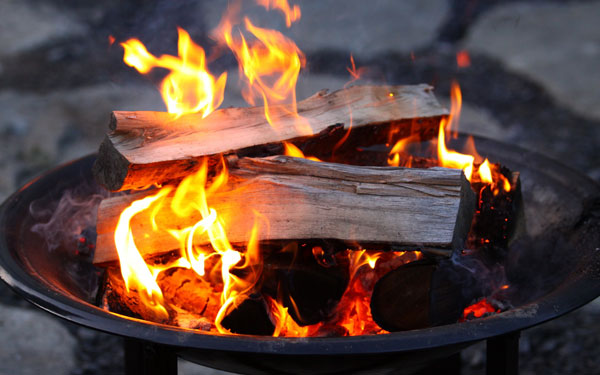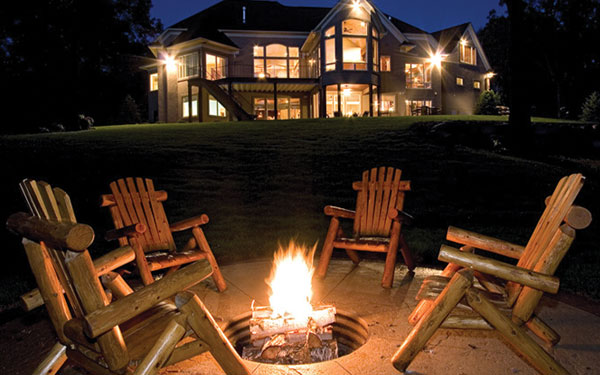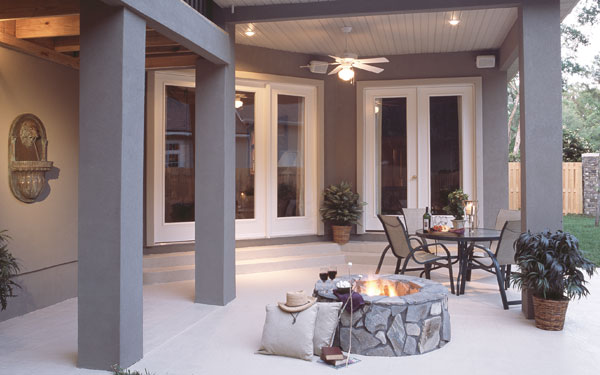 by Jennifer Jones
by Jennifer Jones

There’s nothing quite like the crisp breeze during the fall to take your mind away from all the heat and humidity you weathered all throughout the summer. As soon as the air begins to cool down, our thoughts drift to spending time outdoors again among the colorful fall leaves. Another extremely popular pastime is spending time with family and friends around an outdoor fire pit on those chilly autumn nights.
Besides their warm glow on a cool evening, fire pits can add a lot of flair to an outdoor living space and help extend your time spent in the outdoors when the weather begins to cool down. It’s a great way to gather family and friends and spend quality time together without the blaring television distracting everyone. But, in order to make fond memories around your fire pit, it’s important to take note of the safety issues involved with owning this fantastic outdoor feature.
Before you even begin to look for a fire pit, make sure you have reviewed your city and/or county’s regulations regarding their use. Some cities prohibit their use and fines could be imposed if you don’t follow the rules.

View This House Plan
View Other Luxury House Plans
Start by placing your fire pit on a solid surface and in an open area. The area you select should not be enclosed in any way, so be sure proper ventilation is available in the chosen spot. Be aware that your fire pit is not too close to trees, buildings, your home or other structures and overhanging roof lines. A safe distance is to make sure you have a 10’-20’ circle around your fire pit area. You also want to make sure to have a smooth walking area around the fire pit, so gravel or an uneven surface doesn’t make the area difficult to safely walk around. Once your fire pit has been placed in the proper location, it’s time to get ready to light it. But before lighting, make sure you have quality wood for burning. Good firewood includes pinion wood, alder, cedar, oak, hickory, mesquite, pecan and even fruit woods, such as apple and cherry. Don’t burn pressure-treated wood in a fire pit because it may contain harmful toxins. Next, check the wind direction. A strong wind can make a small, manageable fire turn into an inferno quickly. So, to be on the safe side, try to always have a fire extinguisher nearby when lighting, or at the very least a garden hose. When lighting the fire pit, be sure all children are far away from it and never allow a child to light the fire pit themselves. And, remember it is not necessary to use accelerants to light the fire. Finally, keep your fire small. There’s no need for a blazing bonfire. The bigger the fire, the higher the potential is of danger, so keep it small and it will be just as cozy.

View This House Plan
View Other European House Plans
To get the fire started, place a crumpled piece of paper or a store-bought fire starter in the pit. Cover it with small sticks. As the fire begins to burn, add larger sticks until you are able to add a log or two. When gathering around the fire pit after it is lit, be sure there is enough space between you and the fire pit to avoid sparks and embers from reaching you and your family or guests. Sparks will fly out of the fire pit, so you don’t want to cause injury to anyone that is sitting too close. Make sure all combustible materials have been cleared away from the area where you have placed your fire pit. That includes items such as dry leaves, paper, dry grass or pine needles. And, flammable liquids should be kept well away from fire pits since some of them can catch fire just from the emitting heat. All of these things mentioned above will catch fire very quickly, so it is best to never have any of them near your fire pit area. And, place outdoor furniture far enough away that sparks will not damage it. Using a screen for protection from the wind will prevent sparks from flying out as easily. And, to err on the safe side, do not use your fire pit at all when it is windy.
When your evening of fun begins to wind down, always make sure to completely extinguish the fire before leaving it unattended. Leaving a fire unattended can result in a sudden mishap. Windy conditions could flare up the fire after you’ve gone off to bed and result in damage and unsafe conditions in the blink of an eye. The best way to extinguish a fire is to take the ashes and spread them out over a large surface area and let them cool down. People often use an ash bucket and put all the ashes in there as well. Then take some water and pour it over the ashes until they are completely out.
Also, keep your neighbors in mind. Try to ensure that smoke from your fire pit isn’t hovering over their patio and making their outdoor conditions inhabitable. Check wind directions and be considerate of others around you at all times.
Now that you have all safety measures in place, select a beautiful fire pit to enhance your outdoor surroundings and begin enjoying the crisp, fall air late into the evening surrounded by all of your family and friends.
Here are some related articles:
Save this article to:
back to top